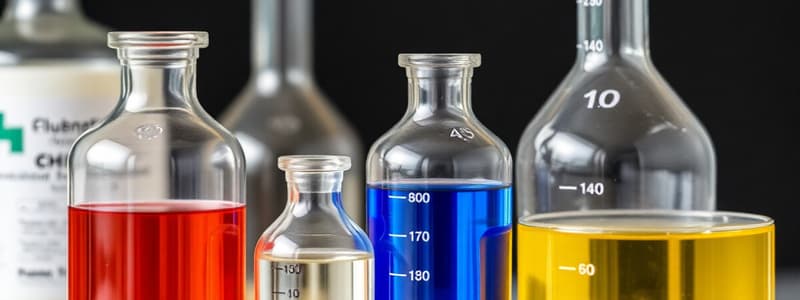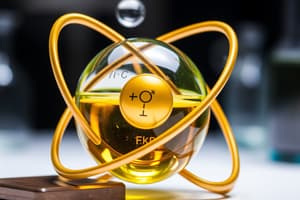Podcast
Questions and Answers
Which of the following correctly describes a homogeneous mixture?
Which of the following correctly describes a homogeneous mixture?
- A mixture that has a uniform composition throughout (correct)
- A mixture that contains only one type of particle
- A mixture with visibly different substances
- A mixture that cannot be separated by physical means
What is the main difference between an ionic compound and a molecular compound?
What is the main difference between an ionic compound and a molecular compound?
- Ionic compounds are made up of atoms that share electrons; molecular compounds do not.
- Ionic compounds are liquid at room temperature; molecular compounds are solid.
- Ionic compounds are formed from metals and nonmetals; molecular compounds are formed from nonmetals only. (correct)
- Ionic compounds always have a high boiling point; molecular compounds do not.
Which of the following statements accurately represents a chemical change?
Which of the following statements accurately represents a chemical change?
- Melting ice into water
- Evaporating water into steam
- Dissolving salt in water
- Burning wood to ash (correct)
What term is used to describe the substances present before a chemical reaction occurs?
What term is used to describe the substances present before a chemical reaction occurs?
In which scenario is biod degradation most likely to occur?
In which scenario is biod degradation most likely to occur?
Flashcards
Element
Element
A substance that cannot be broken down into simpler substances by chemical means. It is made up of only one type of atom. Examples include gold, copper, oxygen.
Heterogeneous Mixture
Heterogeneous Mixture
A mixture with non-uniform composition. Different parts of the mixture can be easily distinguished. Examples include sand and water, or a salad.
Chemical Change
Chemical Change
A change in the chemical composition of a substance. It results in a new substance with different properties. Examples include burning wood, rusting iron.
Compound
Compound
Signup and view all the flashcards
Mass
Mass
Signup and view all the flashcards
Study Notes
Chemistry Vocabulary
- WHMIS: Workplace Hazardous Materials Information System (a system for identifying and classifying hazardous materials).
- Compound: A substance formed when two or more different elements are chemically bonded.
- Heterogeneous Mixture: Mixture in which the components are not uniformly distributed
- Homogeneous Mixture: Mixture in which the components are uniformly distributed.
- Pure Substance: A substance with a fixed composition and uniform properties throughout.
- Chemical Properties: Characteristics that describe how a substance reacts with other substances.
- Physical Properties: Characteristics that can be observed or measured without changing the substance's composition, such as color, density, and melting point.
- Atomic Mass: The average mass of an element's atoms.
- Molecular Compound: A compound composed of molecules.
- Exothermic Reaction: Chemical reaction that releases energy (often in the form of heat).
- Endothermic Reaction: Chemical reaction that absorbs energy (often in the form of heat).
- Physical Change: Change that alters the substance's appearance without changing its composition.
- Chemical Change: Change that alters the substance's composition and creates a new substance.
- Atomic Number: Number of protons in an atom's nucleus.
- Ion and Ion Charge: Charged atoms/groups of atoms formed when atoms gain or lose electrons.
- Ion Charge: The positive or negative electrical charge of an ion.
- Law of Conservation of Mass: Matter cannot be created or destroyed in chemical reactions, only transformed.
- Protons: Positively charged particles found in an atom's nucleus.
- Neutrons: Neutral particles found in an atom's nucleus.
- Electrons: Negatively charged particles that orbit the nucleus.
- Cation: Positively charged ion.
- Anion: Negatively charged ion.
- Bohr Model: A model of an atom that portrays an atom's electrons as orbiting the central nucleus in specific orbits.
Vocabulary
- Organic Compounds: Compounds containing carbon, often found in living organisms.
- Inorganic Compounds: Compounds that do not contain carbon, or if they do, they are considered to behave inorganically.
- Carbohydrates: Organic compounds predominantly made of carbon, hydrogen, and oxygen (e.g., sugars, starches).
- Lipids: Organic compounds that store energy (e.g., fats, oils, waxes).
- Vitamins: Organic molecules needed in small amounts for metabolic processes.
- Nucleic Acids: Organic compounds vital for genetic information storage (e.g., DNA, RNA).
- Saturated Fat: Fats that have only single bonds between carbon atoms, usually solid at room temperature.
- Unsaturated Fat: Fats that have at least one double or triple bond between carbon atoms, usually liquid at room temperature.
- Diffusion: The spreading of a substance from an area of high concentration to an area of low concentration.
- Ingestion: Act of consuming or taking in.
- Osmosis: Movement of water across a semi-permeable membrane from a high to low water concentration.
- Biomagnification: Increase in concentration of harmful substances as it progresses through trophic levels in a food chain.
- Bioaccumulation: The build-up of a substance in an organism over time.
- Toxicity: The degree to which a substance is harmful.
- Dissolved Nitrates and Phosphates: Essential nutrients, dissolved in water.
- PPB (Parts per Billion): A measure of concentration
- PPT (Parts per Ten Thousand): A measure of concentration.
- PPM (Parts per Million): A measure of concentration.
- LD50: Lethal dose for 50% of test population.
- Pesticide: Substance used to kill harmful pests.
- Remediation: Effort to undo or repair ecological damage.
- Effluent: Wastewater or liquid industrial discharge.
- Biological Indicators: Organisms sensitive to environmental changes, used to measure pollution levels.
- pH Scale: Scale indicating acidity (0-7), neutrality (7) and alkalinity (7-14).
- Pollutant: Substance that contaminates the environment.
- Dispersion: Spreading of particles throughout a region.
- Leach: Process of dissolving and removing matter from a substance.
- Base: In chemistry, a substance that accepts protons to become neutral.
- Pollution: Contamination of the environment due to harmful substances.
- Turbidity: Measure of cloudiness in a liquid.
- Universal Indicator: A solution that changes color depending on the pH of a solution.
- Litmus Paper: Paper that changes color depending on whether it's in an acidic, basic, or neutral solution.
- Tailings Ponds: Bodies of water that contain waste from mining operations.
- Groundwater: Water located beneath the earth's surface.
- Acid Rain: Rain that has a lower pH than normal.
- Proteins: Large organic molecules, made of amino acids, used for structure, function, and regulation.
- Nutrients (Macro/Micro): Chemical components essential for life processes.
Studying That Suits You
Use AI to generate personalized quizzes and flashcards to suit your learning preferences.




